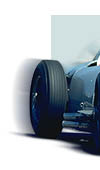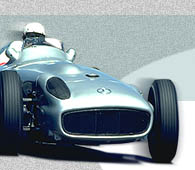Revised January 2007
It is our preference to see cars restored to
their original condition and specifications.
That is to say, to the same state as when it was originally produced
and raced. Racing options that were available at the time and
specified for use on that particular model (homologated) are allowed.
Cars may have been raced over a number
of years in various classes under an assortment of regulations.
We wish to establish a clear understanding of the "point
in time" (i.e., 1932, 1965, 1969) to which a car is restored.
Modifications which are not in keeping with that "point in
time" are not allowed. Modifications which improve performance
over that of a car from that "point in time" are not
allowed. Modifications such as modern valve train replacements
(roller rockers, etc.), blocks, gearboxes, vented discs are not
acceptable!
ENGINE: The engine must be
of the original type and specifications as homologated when the
car was produced. Displacement, carburation and valve train must
be original in specification and material.
WHEELS: Cars must run on wheels
of the same type and size as were specified by the manufacturer
at the time. We refer specifically to rim width, diameter and
off set as specified in the manufacturer’s homologation
statement. A maximum of .5” increase in the rim
width is allowed.
In certain instances for safety reasons the
offset of wheels may be altered. Requests should be made to this
office in writing.
Wheels must be free of cracks and faults. (Have
them crack tested.) Spokes must be properly tensioned.
Bolt on Rudge Whitworth Spline adapters must
have a paint strip indicating the adapters are secure.
Dual master cylinders are recommended.
TIRE RULES: Tires must approximate,
as closely as possible, the dimensions of the tires originally
available on the car at the time of manufacture or the “Point
in Time to which it is restored”; this refers specifically
to diameter, cross section and tread width.
TREAD PATTERN: All tires must have a molded tread
pattern of period design, no semi-slick tread. Some classes, Historic
Trans-Am, F-1, Can-Am and selected FIA Sports Cars are exempted
from this rule and may run Slicks. (Check with event organizer)
COMPOUND: Tires must be of a manufacturers "Hard"
compound.
Note: Tire design has progressed dramatically since the early
1960s. In fact it has been the leading field toward the development
of modern racing cars. Lower profiles and wider cross sections
came into play in 1964 and it has been constant change ever since.
Tire companies that are currently making vintage racing tires
for “vintage” cars (thru 1962) are Dunlop and Coker.
The Coker tires branded “Excelsior Comp” are new and
unproven as yet. Goodyear makes a racing tire they refer to as
vintage but should not be confused with the tires they made back
in the late 50s and early 60s. The current tires are considerably
different in dimension even though they may be listed as a certain
size. The size indicated on the side wall of some current tires
does not mean that the dimensions of the tries are the same as
an original tire with the same listed size. These tires and tires
made by Avon are lower profile, wider and stickier. They are suited
to cars of the late 60s thru the 70s.
You should be aware that the softer, stickier
compounds developed by the tire companies increase cornering loads
to a point beyond the limits originally designed in to the cars
and which has translated into possible suspension overload and
failure.
CLASS TIRE REQUIREMENTS:
Note: There may be some individual tires that may also approximate
original tires for a specific car. These might include a 70 series
radial tire. A request to use such tires will be considered if
they are truly appropriate.
Englebert tires are no longer available. Blockley
tires have been well received.
G-1, G-2: 1955-1962
G-3, G-4: 1962-1965
Interior: Modifications to
the interior that reduce the weight of the car are not allowed,
with the following exceptions: 1) Floor mats or rugs may be removed.
2) Window glass may be removed from doors.
The removal of interior trim (gutting) is not permitted.
The cars must have 2 seats (original and/or period bucket seats
is allowed), original dash board (you may exchange or add instruments),
interior door panels.
Installed safety equipment may not have any influence whatever
on the mechanical performance of the car.
Exterior:
1) Tops may be removed from open cars.
2) Bumpers may be removed, but if so, all projecting hardware
such as brackets must also be removed.
3) Grills may not be removed.
4) Windshields may be replaced by a suitable windscreen.
5) Lighting equipment must remain in place.
6) Headlights should be taped.
Brakes:
Must be of the original type and specifications as homologated
when the car was produced.
Engines:
Must be original as previously stated in the general rules. Modern
valve train replacements such as roller rockers, titanium valves,
etc. are not allowed. Dry sump systems that were not originally
fitted to the specific car are not allowed. Headers are allowed.
Transmission & Differential:
Must be of the original type, as produced. Gears and ratios as
originally offered.
Minimum Weight:
The minimum weight allowed is that listed in the SCCA Rule Book,
Production Car Specifications, 1962 for G-1 & G-2 and 1965
for G-3 & G-4, less 7%.







